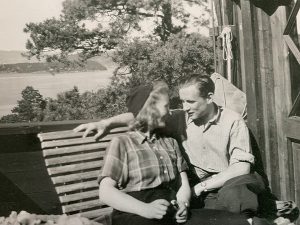A Love Story
Published on February 13, 2023 at 1:46pm CST
View From a Prairie Home
by Hege Hernfindahl, Columnist
 When you read this, it’s Valentine’s Day. The day of love. You probably have read or heard of St. Valentine, the 3rd century Roman saint, who supposedly defied the emperor’s orders and secretly married couples to spare the husbands from war. Maybe you also have heard about the different kinds of love. I will define them quickly; Eros is romantic or erotic love. Philia is love between friends. Storge is love of parents for children. And Agape is love for mankind and also God’s love for us.
When you read this, it’s Valentine’s Day. The day of love. You probably have read or heard of St. Valentine, the 3rd century Roman saint, who supposedly defied the emperor’s orders and secretly married couples to spare the husbands from war. Maybe you also have heard about the different kinds of love. I will define them quickly; Eros is romantic or erotic love. Philia is love between friends. Storge is love of parents for children. And Agape is love for mankind and also God’s love for us.
I think that the kinds of love overlap at times. I certainly have both the eros and the philia kind of love for my husband. And for my children and grandchildren, I have the storge and philia kind of love.
But it being Valentine’s Day, I thought I would write a love story. I know I have written about it before, but I only have so many love stories available to tell. The story is inspired by a picture sent to me by my mother’s best friend, Aase, after my mother died.
It shows a beautiful spring day. My parents are sitting on a bench with only eyes for each other. It is very easy to see that they are very much in love and very happy. In the background is the Oslo fjord.
On the backside of the photo, Aase wrote 1946. I know their story and I know why they are so happy. Behind them were five years of struggle, darkness, danger and longing.
They met at the University of Oslo where they both studied Applied Economics. (Just like their grandson, Erland, did many years later.) But it was 1940 and Norway was occupied by the Nazis. Soon, they spent less time at the university and instead were busy with their different work for the Norwegian Resistance. My father joined Milorg which was a resistance organization that quickly sprang to life because young people wanted to fight the Nazis. Milorg was also called “Gutta på skauen” (the boys in the forest) because the men (mainly) trained in the vast forests surrounding Oslo. My mother joined a circle, which gathered news received illegally from England. Then, they made newspapers with the real news of how the war was going. Correct information was crucial for the people of occupied Norway since all news was censored and nobody knew what really was going on. Anybody caught being in the resistance was killed.
I have written many times about how my father had to flee to Sweden in 1943, where he trained with the other Milorg members. He wrote letters to my mother and pretended to be Swedish, because the mail was censored.
The war was hard for civilians in Norway. Everything people needed to live was hard to come by. You couldn’t buy new clothes, so my mother and her four sisters would take every scrap of clothing and material in their house and make new clothes. You couldn’t buy shoes, but you could get new soles at a shoemaker’s. My mother had shoes made of fish skin with wooden soles. She also had a skirt made of potato sacks. Food was also scarce. My aunt got scurvy from lack of fresh fruit.
May 8, 1945, the war was suddenly over. The Nazis just left. There were no battles. My father was stationed in Narvik, Central Norway for a few months with his fellow soldiers to help flush out hidden Nazis. My mother went to Narvik by train through Sweden to see if they were still a couple.
1946 was the first year of complete peace. My parents went back to the university. The picture was taken before my mother got tuberculosis and had to spend a year at a sanatorium. They were young with their whole life ahead of them and they were filled with love for each other and for this new world of peace.




